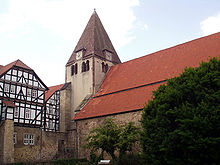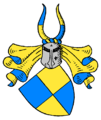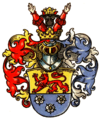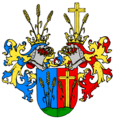Old Hessen knighthood
The Althessische Ritterschaft is an association of the former knightly Hessian nobility, to which the former sovereigns from the House of Hesse also belonged. Today it is set up as a foundation and is known under the name of the Knightly Stift Kaufungen or Stift Kaufungen. The Knighthood of Kaufungen, the formal association of the Knights of the Old Hessen , has existed since 1532, making it the oldest foundation in Hesse . It is located in the former Kaufungen monastery .
The members of the Old Hessen Knighthood are listed in a register and administer the Kaufungen Knighthood Foundation.
history
The foundation of the Old Hessen Knighthood is registered with the regional council of Kassel ( foundation supervision ) as the knightly foundation Kaufungen and the oldest foundation in Hessen.

In 1527, as part of the Reformation , Landgrave Philipp von Hessen closed, among other things, the Kaufungen monastery , in 1532 the Wetter and Kaufungen monasteries were combined to form the Kaufungen and Wetter monastery and handed over to the Hessian knighthood. This monastery was also built to support the single noble ladies who were left unsupervised after the abolition of the monasteries. In addition, the pen served to protect the other knightly family members. The Knighthood of Old Hessen continued to exist in both principalities, Hessen-Kassel and Hessen-Darmstadt , after the Hessian inheritance was divided . For a time the Südstift existed for Hessen-Darmstadt .
Family members in need from the Althessian Knighthood, the Kurhessische Diakonie and various charitable purposes as well as other needy people from Hessen are supported by donations from the assets of the foundation.
The registry of the Old Hessen Knighthood - what is meant here is the old legal foundation of the Old Hessen Knighthood, and not all local Hessian knight families - was kept from 1632. Previously, the members of the knightly families were habitually admitted to the Hessian estates - they were able to do so - without having to personally own land (a manor ). In the Holy Roman Empire of the late Middle Ages, the land estate was mostly available to all nobles in a region as a personal right, but later turned into a real right that was connected with the possession of a manor and adhered to it; Membership in the Old Thessian Knighthood as a personal right for members of enrolled families is in this respect a remnant and legal monument of that late medieval tradition. Their continued existence is also related to the real division of property in inheritance, which in the Hessian nobility - in contrast to other regions - often remained common .
Around 1760, according to Heinrich Berghaus ' incomplete list, the Hessian knighthood counted (in brackets the number of goods eligible for the Landtag, if more than one):
- Baumbach (11)
- Berlepsch , Treasurer of Hesse (5)
- Biedenfeld
- Bischoffshausen (2)
- Bodenhausen
- Boyneburg , e.g. T. also called Hohenstein (8)
- Brink
- Buseck , also called Münch
- Buttlar (5)
- Calenberg (2)
- Capella
- Cornberg
- Dalwigk (4)
- Dornbach (3)
- Diede zum Fürstenstein (5)
- Donop
- Döring (2)
- Dörnberg , Hereditary Chef of Hesse (2)
- Kite (2)
- Eschwege (2)
- Fleckenbühl called Bürgel
- Gall
- Gilsa (4)
- Habell
- Hertingshausen
- Heydwolff
- horn
- Hottenbach
- Hundelshausen (3)
- Keudell (3)
- garlic
- Lindau
- Löwenfeld
- Lion's Arch (4)
- Lütter
- Malsburg (7)
- Meysenbug (4)
- Milchling (3)
- Münch
- nail
- Pappenheim (2)
- Pretlack
- Radenhausen
- Rau zu Holzhausen (2)
- Riedesel zu Eisenbach , Hereditary Marshals of Hesse (> 2)
- Roding
- Romrod (3)
- Rothsman
- Scheffer
- Shafts
- Scholetz
- Schenk zu Schweinsberg , inheritance from Hesse (> 2)
- Schwertzell
- Seebach
- Sayboltsdorf
- Mirror (3)
- Stein-Liebenstein
- Stockhausen
- Treusch of Buttlar (6)
- Trohe
- Trott to Solz (4)
- Urff
- Verschuer (2)
- Vultée (3)
- Vrede
- Wambolt from Umstadt
- Weitershausen
- winter
- Wolff von Gudenberg
- Wallenstein
- Worm
There is a need for research to determine whether, in connection with the naming of the knightly sex by Heinrich Berghaus, membership in the old legal foundation Althessische Knighthood goes hand in hand.
Already before 1760 the
- Falkenberg †
- Handles †
- Lever †
- Holzsadel †, hereditary chef of Hesse from 1483 to 1520
- Leimbach †
- Röhrenfurth †, hereditary marshals of Hesse until 1432
- Schrendeisen †
The Hessian constitution of 1831 stipulated that the Knighthood of Althess and the Kaufungen Abbey were each allowed to send one representative to the Hessian assembly of estates . In the years 1830–1832 and 1838–1848, Friedrich Heinrich Ludwig Wilhelm von Trott zu Solz was the head of the Kaufungen Abbey .
Foundation, endowment
The respective Hereditary Marshal of Hesse from the family of the Barons Riedesel zu Eisenbach nominally presided over the knighthood. Even after the abolition of the privileges of the nobility, the chairman still has the internal title of Hereditary Marshal. In accordance with the statutes, the Knighthood Foundation is run by three chiefs appointed from among the members. The seat of the foundation is in the former Kaufungen monastery near Kassel.
The foundation supervision lies with the regional council Kassel , which runs the foundation today as the knightly foundation Kaufungen .
Today's purpose of the foundation is to pursue charitable and benevolent purposes by donating marriage taxes to needy widows and children from families of the old Hessen knighthood as well as aid to other needy people living in today's state of Hessen, as well as donations to recognized charitable institutions and associations in the state of Hessen granted. Charitable purposes will continue to be pursued by maintaining the monastery buildings under monument protection in accordance with the requirements of the state monument protection and maintaining the archive in the Kaufungen monastery and making it usable for research. The municipality of Kaufungen and the surrounding communities are also supported. Church purposes are pursued, among other things, because the monastery is the owner of the collegiate church in Oberkaufungen .
While the members of the Althessian Knighthood until 1873 adhered to the confession of the unchanged Augsburg Confession , which is still represented by the Protestant Althessian Church , there is no longer any connection between these two organizations.
Wallenstein Abbey
In 1992 the formerly independent Wallenstein Abbey, located in Fulda, was merged with the Althessian knighthood. Countess Maria Amalia von Schlitz called von Görtz, née von Wallenstein , was the last of the Hessian Wallensteins , originally resident at Wallenstein Castle in Knüll , to donate this pension facility for countess and noble women of Protestant faith in Homberg (Efze) in her will in 1759 , and also to be Kaiser Franz I had confirmed this. The monastery was moved to Fulda in 1832 as a result of the so-called Dörnberg uprising of 1807.
Members
The current members of the Althessian knighthood come from the families listed below. Families whose male line became extinct from the 20th century in Hesse introduce † as a designation. Other rural, knightly families, which had already expired before the donation of the monastery, are marked with •. This part of the list is very sketchy.
Former holder of Hessian court offices
Riedesel barons of Eisenbach , hereditary marshals of Hesse (incumbent from 1432); the respective Hereditary Marshal nominally presides over the knighthood. The von Röhrenfurth • preceded the Riedesel in office.
Barons Schenck zu Schweinsberg , inheritance gifts from Hesse (incumbent from 1369)
Counts and Barons von Berlepsch , Chamberlain of Hesse (incumbent from 1369)
Imperial barons of Dörnberg , hereditary kitchen master ( hereditary steward) of Hesse (incumbent from 1732). The Nassenerfurth wood nobility • held the office of master kitchen master from 1483 to 1520.
Alphabetical
Barons and Lords of Amelunxen
Lords of Baumbach
Lords of Biedenfeld
Barons and Lords of Bischoffshausen
Barons of Bodenhausen
Lords of Boyneburg, tribe A
Lords of Boyneburg, tribe B
Barons Breidenbach zu Breidenstein (temporarily at the former Südstift (Hessen-Darmstadt))
Barons von Buseck (temporarily with the former Südstift (Hessen-Darmstadt))
Barons and Lords of Buttlar , see also below: Treusch von Buttlar-Brandenfels
Barons von Canstein the Hessian line of the family is †
Barons of Cornberg †
Barons of Dalwigk zu Lichtenfels
Lords of Eschwege
Barons and gentlemen from and to Gilsa
Lords of Hertingshausen
Lords of Hessberg
- Mr. von Heydwolff
- Lords of Hundelshausen
Lords of Keudell †
Lords of Knoblauch zu Hatzbach
Barons von Leonhardi (temporarily with the former Südstift (Hessen-Darmstadt))
Barons and Lords of Linsingen
Lords of the Malsburg
Gentlemen Milchling von Schönstadt †
Lords of Osterhausen
Herr Rabe von Pappenheim
- Rau from and to Holzhausen and Nordeck †
- Barons von Rotsmann (temporarily at the former Südstift (Hessen-Darmstadt))
Lords from and to Schachten †
Gentlemen from Schutzbar called Milchling
Barons von Stein-Liebenstein zu Barchfeld (membership suspended after Soviet expropriation)
Lords of Stockhausen
Barons and Lords Treusch von Buttlar zu Brandenfels , see also above: Barons and Lords von Buttlar
Gentlemen from Trott zu Solz
Gentlemen from and to Urff
Barons von Verschuer
Barons Waitz von Eschen
Barons Wambolt von Umstadt (temporarily at the former Südstift (Hessen-Darmstadt))
Barons Wolff von Gudenberg
- and since December 6, 1963 the descendants of Harald Elsner von Gronow and Friedericke von der Malsburg, under the name of Messrs. Elsner von der Malsburg
Knightly families extinguished before the donation of the monastery (selection)
- Röhrenfurth •, until 1432 Hereditary Marshals of Hesse
- Holzsadel •, hereditary kitchen master of Hesse from 1483 to 1520
- Step iron •
Web links
- Homepage Kaufungen Abbey
- Studbook of the Old Hessen Knighthood, containing the family tables of the families belonging to the Old Hessen Knighthood residing in the former Electorate of Hesse, edit. by Rudolf von Buttlar-Elberberg, Wolfhagen 1888
- Information about the monastery with pictures ( Memento from October 9, 2007 in the Internet Archive )
- Article from 1788 about the Ritterstift









































